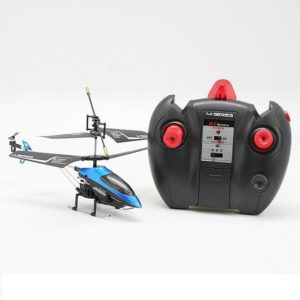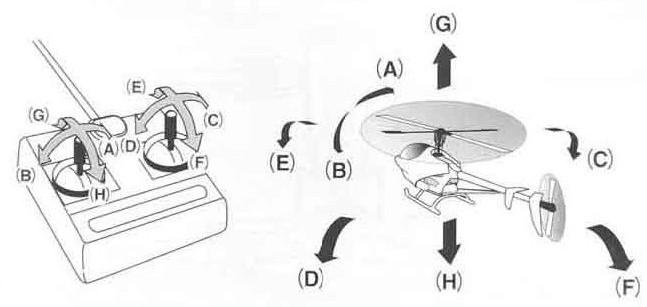Everything started when I got myself a coaxial RC helicopter for Christmas. I was playing with the idea for quite some time, and the moment seemed perfect to waste some money. Since then I have learned quite a lot about how helicopters work an by now I have moved on to a more capable helicopter. Unfortunately it is also more expensive to fly.. This post shall explain some general topics about RC helicopters which are useful if you are also considering getting a RC helicopter yourself. One can already get a small indoor RC helicopter for about 30€, but most likely you will get bored flying it after a few days. If you want to have something that lasts longer, there are some things you should consider, which we will discuss next.
The remote Control
The idea to buy an helicopter first came up, when I saw an Infra Red (IR) controlled coaxial helicopter RC in a local coffee shop. It came with an traditional Remote Control (TX) as well as an IR module attachable to the headphone jack of my smart-phone. While the idea to control the helicopter with your phone sounds cool in the first place, it actually is not. If you ever tried to play a game with a digital-controller on the touch-screen, you will know what I mean. As there is no haptic feedback it is very difficult to give precise input without looking at the touchscreen all the time. So the smart-phone module is actually quite a useless gadget.
The other problem with that package is the Infra Red transmission technology – basically the same you have in your TV remote. Therefore it also suffers from the same shortcomings; if there is an object between you and the helicopter it is pure chance if it will receive a signal or not. Next the transmission is quite sensitive as there are many natural IR source around like the sunlight, heat or even light-bulbs. As one wants the transmission as reliable as possible, you should avoid IR remote controls.

An alternative transmission technology is radio in the 2.4Ghz spectrum, which is not only more reliable but also has a larger operation range. Fortunately 2.4Ghz radio controllers are not more expensive than the older IR controllers, so pay attention to get one of these. If you want to learn more on the used radio technology I recommend the Wikipedia article on Radio Gear.
How many channels do I need
Looking at the offered helicopters some are advertised as 3 channel or 4 channel. But how many channels do you need? First lets take a step back and explain what channel actually means in this context. Lets look at a simple remote controlled car for this. It can either go forward or backward and left or right. The important word here is “and”. As the car can go for instance forward and left, we need two independent communication channels: one for steering and one for acceleration.
Obviously a helicopter needs more channels; besides steering and accelerating forward and backward it can also lift or fall (throttle). So we need at least 3 channels to be able to do something with it. Now steering left and right can mean two things in the case of helicopters. Either you can rotate around the main rotor axis (yaw) or go straight left or right along the horizontal axis (cyclic bank). Therefore you need 4 channels to be control all possible movements of the helicopter.

But even though 4 channels are enough to control the movements, you actually need 5 channels to fly advanced manoeuvres like flying upside down or flying loops. You can think of the 5th channel as the gear stick in the car which changes the transmission. For helicopters the transmission roughly corresponds in the pitch of the rotor blades – and this is exactly what the 5th channel is for. But to fully understand why you need it, you have to understand how the physics of a helicopter work.
How real helicopters work
Instead of explaining all the theory by myself, I rather point you to Destins “Smarter Every Day” Series. They are really entertaining to watch and you get to know everything you need about RC helicopters physics – they are actually using a RC helicopter to explain the physics behind real ones.
You probably noticed that real helicopters are also quite fragile if not handled properly. That aside you should now also know that the 5 channel helicopters are called collective pitch and which manoeuvres you can do with them.
So what should you buy
After watching the 3D flight demos above, you probably want to go with a collective pitch helicopter straight ahead. But remember that it probably took the pilot years of practice and hundreds of € in spare parts to learn how to fly like that. There will be no “inverted flight” button on the remote control. Therefore you probably should start with a cheap 4 channel helicopter to see whether you enjoy flying enough to spend more time and money on it. The only thing you should observe with your first helicopter is that there should be spare parts available. Otherwise your first crash might cost you the whole 30€ of the helicopter instead of just 5€ for a spare rotor blade. This does not mean you neccesarily have to buy from a brand, which is more expensive. I ended up with a coaxial helicopter called “super uncommon 9998”, which could use the spare parts of the e-flite blade MCX system.
You should practice the basic manouvers with that cheap helicopter, as it will survive more crashes due to its slower flight speed. I recommend the rchelicopterfun youtube tutorial for an overfiew of exercices. You will need a collective pitch flybarless helicopter for the later ones, but you can do the first ones with a coaxial helicopter just as fine.
Once you are hooked up and decide to buy a more expensive collective pitch helicopter, you might be interested in my experiences with the Nine Eagles Solo Pro 125.This was just a small outline of the broad RC helicopter topic. If you want to know more I recommend you the excellent rchelicopterfun website.